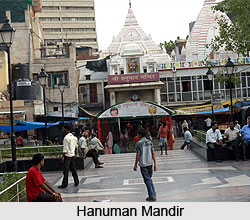 This 18th century Hanuman Mandir is a legendary Hindu temple situated on the Baba Kharak Singh Road (Old Irwin Road), about 250m southwest of Connaught Circus in Central Delhi. One of the oldest Hanuman Temples ever built; it was built by Maharaja Jai Singh in 1724. The idol of this strange temple is a swayambhu (self-created). However, since the time of its construction, the temple has undergone numerous restorations. None of the highlights of the temple is the 24-hour chanting of the mantra `Sri Ram, Jai Ram, Jai Jai Ram` since August 1, 1964. This continuous chanting has even secured a place in the Guinness Book of World Records.
This 18th century Hanuman Mandir is a legendary Hindu temple situated on the Baba Kharak Singh Road (Old Irwin Road), about 250m southwest of Connaught Circus in Central Delhi. One of the oldest Hanuman Temples ever built; it was built by Maharaja Jai Singh in 1724. The idol of this strange temple is a swayambhu (self-created). However, since the time of its construction, the temple has undergone numerous restorations. None of the highlights of the temple is the 24-hour chanting of the mantra `Sri Ram, Jai Ram, Jai Jai Ram` since August 1, 1964. This continuous chanting has even secured a place in the Guinness Book of World Records.
The Hanuman Temple has withstood the Mughals` onslaught on the numerous Hindu temples. There is a crescent moon symbol in the vimana, unlike the `Aum` or Sun symbols above the vimana as in other Hindu shrines. This might the reason why the Mughals did not destroy the temple. The idol of the New Delhi Hanuman Mandir represents the Lord in a very young age, that of a `balak` (young boy). The idol faces south and is called the Bala Hanuman. In His left hand he holds a `Gada` (a heavy weapon of ancient times) and His right hand rests over his chest, as in prayer. The main `Dwar` (entrance gate) of the temple is ornamented with imprinted artwork that depicts the epic Ramayana completely. Just below the paintings, the entire verses of Sundarakant of Swami Thulsidas`s Ramacharitha Manas have been engraved in marble slabs. The temple was rebuilt and renovated during the late 70s by the New Delhi Municipal Council with great care and serves as hub for the religious activities. Apart from being considered a sacred place, the temple is also known for `mehendi` work done on the hands of ladies outside the Mandir. The temple gains special significance on Tuesdays, when it is thronged by thousands of devotees.











